C++: I/O流详解
一、输入流操作
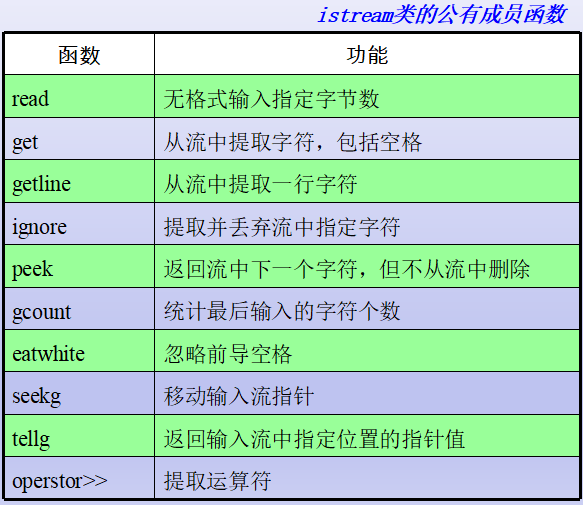
1.read 无格式输入指定字节数
istream& read ( char* pch, int nCount );
istream& read ( unsigned char* puch, int nCount );
istream& read ( signed char* psch, int nCount );
2.get 从流中提取字符,包括空格
int get();
istream& get( char* pch, int nCount, char delim = '\n' );
istream& get( unsigned char* puch, int nCount, char delim = '\n' );
istream& get( signed char* psch, int nCount, char delim = '\n' );
istream& get( char& rch ); istream& get( unsigned char& ruch );
istream& get( signed char& rsch );
istream& get( streambuf& rsb, char delim = '\n' );
3.getline 从流中提取一行字符
istream& getline( char* pch, int nCount, char delim = '\n' );
istream& getline( unsigned char* puch, int nCount, char delim = '\n' );
istream& getline( signed char* psch, int nCount, char delim = '\n' );
4.ignore 提取并丢弃流中指定字符
istream& ignore( int nCount = 1, int delim = EOF );
5.peek 返回流中下一个字符,但不从流中删除
int peek();
6.gcount 统计最后输入的字符个数
int gcount() const;
7.eatwhite 忽略前导空格
void eatwhite();
8.seekg 移动输入流指针
istream& seekg( streampos pos );
istream& seekg( streamoff off, ios::seek_dir dir );
9.tellg 返回输入流中指定位置的指针值
streanpos tellg();
10.operator >> 提取运算符
basic_istream& operator>>( basic_istream& (*pf)(basic_istream&));
basic_istream& operator>>( basic_ios<E, T>& (*pf)(basic_ios<E, T>&));
basic_istream& operator>>( ios_base<E, T>& (*pf)(ios_base<E, T>&));
basic_istream& operator>>( basic_streambuf<E, T> *sb);
basic_istream& operator>>(bool& n);
basic_istream& operator>>(short& n);
basic_istream& operator>>(unsigned short& n);
basic_istream& operator>>(int& n);
basic_istream& operator>>(unsigned int& n);
basic_istream& operator>>(long& n);
basic_istream& operator>>(unsigned long& n);
basic_istream& operator>>(void *& n);
basic_istream& operator>>(float& n);
basic_istream& operator>>(double& n);
basic_istream& operator>>(long double& n);
例子:
//用get函数从键盘输入字符
void f1(){
char c;
cout<<"Enter first sentence followed by enter\n";
while((c = cin.get())!='\n')
cout.put(c);
cout<<endl; cout<<"Enter second sentence followed by enter\n";
while(cin.get(c)){
if (c == '\n')
break;
cout.put(c);
}
cout<<endl; cout<<"Enter thired sentence followed by enter\n";
char s[];
cin.get(s, );
cout<<s<<endl;
}
输出:
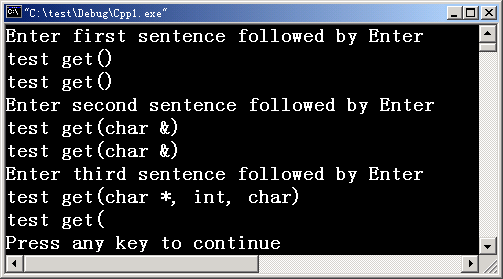
二、输出流
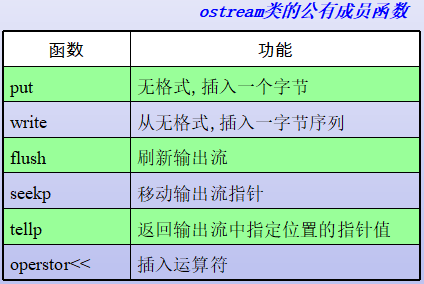
1.put 无格式,插入一个字节
ostream& put(char ch);
2.write 从无格式,插入一字节序列
ostream& write( const char* pch, int nCount );
ostream& write( const unsigned char* puch, int nCount );
ostream& write( const signed char* psch, int nCount );
3.flush 刷新输出流
ostream& flush();
4.seekp 移动输出流指针
ostream& seekp( streampos pos );
ostream& seekp( streamoff off, ios::seek_dir dir );
5.tellp 返回输出流中指定位置的指针
streampos tellp();
6.operstor<< 插入运算符
basic_ostream& operator<<( basic_ostream& (*pf)(basic_ostream&));
basic_ostream& operator<<( basic_ios<E, T>& (*pf)(basic_ios<E, T>&));
basic_ostream& operator<<( ios_base<E, T>& (*pf)(ios_base<E, T>&));
basic_ostream& operator<<( basic_streambuf<E, T> *sb);
basic_ostream& operator<<(const char *s);
basic_ostream& operator<<(char c);
basic_ostream& operator<<(bool n);
basic_ostream& operator<<(short n);
basic_ostream& operator<<(unsigned short n);
basic_ostream& operator<<(int n);
basic_ostream& operator<<(unsigned int n);
basic_ostream& operator<<(long n);
basic_ostream& operator<<(unsigned long n);
basic_ostream& operator<<(float n);
basic_ostream& operator<<(double n);
basic_ostream& operator<<(long double n);
basic_ostream& operator<<(void *n);
例子:
#include<iostream.h>
void main()
{ cout << "Enter a sentence followed by Enter\n" ;
char s[ ] ;
cin.getline ( s, ) ;
cout.write(s, ) ;
cout<<endl;
}
输出:
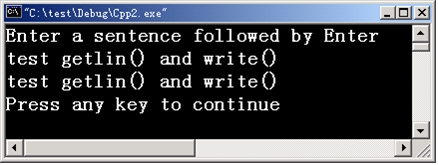
三、流错误状态
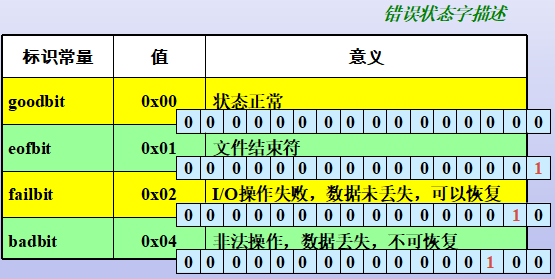
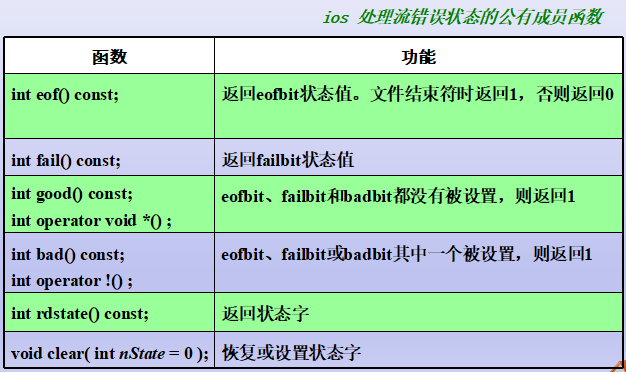
C++: I/O流详解的更多相关文章
- 基于JavaSE阶段的IO流详解
1.IO流基本概述 在Java语言中定义了许多针对不同的传输方式,最基本的就是输入输出流(俗称IO流),IO流是属于java.io包下的内容,在JavaSE阶段主要学下图所示的: 其中从图中可知,所有 ...
- CSS布局之脱离文档流详解——浮动、绝对定位脱离文档流的区别
1.代码 (1)示例代码1 <!DOCTYPE html> <html lang="zh"> <head> <meta charset=& ...
- Spring Cloud Zuul 限流详解(附源码)(转)
在高并发的应用中,限流往往是一个绕不开的话题.本文详细探讨在Spring Cloud中如何实现限流. 在 Zuul 上实现限流是个不错的选择,只需要编写一个过滤器就可以了,关键在于如何实现限流的算法. ...
- [视频播放] HLS协议之M3U8、TS流详解
本文转载自:<hls之m3u8.ts流格式详解> HLS,Http Live Streaming 是由Apple公司定义的用于实时流传输的协议,HLS基于HTTP协议实现,传输内容包括两部 ...
- Spring Cloud限流详解
转自:https://blog.csdn.net/tracy38/article/details/78685707 在高并发的应用中,限流往往是一个绕不开的话题.本文详细探讨在Spring Cloud ...
- Spring Cloud(十二):Spring Cloud Zuul 限流详解(附源码)(转)
前面已经介绍了很多zuul的功能,本篇继续介绍它的另一大功能.在高并发的应用中,限流往往是一个绕不开的话题.本文详细探讨在Spring Cloud中如何实现限流. 在 Zuul 上实现限流是个不错的选 ...
- web前端学习(四)JavaScript学习笔记部分(5)-- 事件流详解
1.JS事件详解-事件流 1.1.事件流 1.事件流: 描述的是在页面中接受事件的顺序 2.事件冒泡: 由最具体的元素接收,然后逐级上传播至最不具体的节点(文档) 3.事件捕获: 最不具体的节点先接收 ...
- IO流详解
目录 IO流 IO流概述及其分类 IO概念 流按流向分为两种: 流按操作类型分为两种: 常用的IO流类 字节流的抽象父类: 字符流的抽象父类: InputStream & FileInputS ...
- Java io流详解四
转载地址:http://www.cnblogs.com/rollenholt/archive/2011/09/11/2173787.html 写在前面:本文章基本覆盖了java IO的全部内容,jav ...
- java IO流详解
流的概念和作用 学习Java IO,不得不提到的就是JavaIO流. 流是一组有顺序的,有起点和终点的字节集合,是对数据传输的总称或抽象.即数据在两设备间的传输称为流,流的本质是数据传输,根据数据传输 ...
随机推荐
- angular +H5 上传图片 与预览图片
//index.html <form class="form-horizontal"> <div class="panel panel-default& ...
- 一次调用cloudera的的API和JSON想到的
JSON的null字段 在我的项目中修改了YARN的资源池,到cloudera中就报错,查询还不报错,但是修改的时候,就报错,大致意思就是信息有异常,“包含了尖括号. 因为通过API+json交互,我 ...
- Java实现Queue类
Java实现Queue类 import java.util.Iterator; import java.util.NoSuchElementException; import java.util.Sc ...
- 四、ABP 学习系列 - 配置Swagger
一.再XX.Web项目中用Nuget安装Swashbuckle.AspNetCore.SwaggerGen和Swashbuckle.AspNetCore.SwaggerUI 二.在Startup.cs ...
- shell脚本 - 快速到达目录
服务器中存放很多工程目录,通过ssh登录,需要手动敲命令,很麻烦,可以建立自动登录脚本 1.在服务器登录是默认的目录中建立脚本文件 vi drivers.sh #建立登录脚本 cd data/work ...
- LTE-V2X车联网无线通信技术发展
2017年9月7日,国家制造强国建设领导小组车联网产业发展专项委员会第一次全体会议在北京召开.会议要求“要加大关键产品研发攻关力度,完善测试验证.技术评价.质量认证等公共服务平台,促进LTE-V2X车 ...
- sql语句中GROUP BY 和 HAVING的使用 count()
在介绍GROUP BY 和 HAVING 子句前,我们必需先讲讲sql语言中一种特殊的函数:聚合函数, 例如SUM, COUNT, MAX, AVG等.这些函数和其它函数的根本区别就是它们一般作用在多 ...
- Celery-4.1 用户指南: Canvas: Designing Work-flows(设计工作流程)
签名 2.0 版本新特性. 刚刚在calling 这一节中学习了使用 delay 方法调用任务,并且通常这就是你所需要的,但是有时候你可能想将一个任务调用的签名传递给另外一个进程或者作为另外一个函数的 ...
- redis学习五 集群配置
redis集群配置 0,整体概述 整体来说就是: 1,安装redis 2,配置多个redis实例 3,安装 ruby和rubygems 4,启动red ...
- Android 4学习(3):概述 - Resources
在应用程序中,处理与代码逻辑无关资源的最佳实践是将其放到程序的外部,典型的资源包括字符串,图片等.Android中的资源文件都在res文件夹中,这些资源包括字符串,颜色,主题,样式,图画,布局,动画, ...
